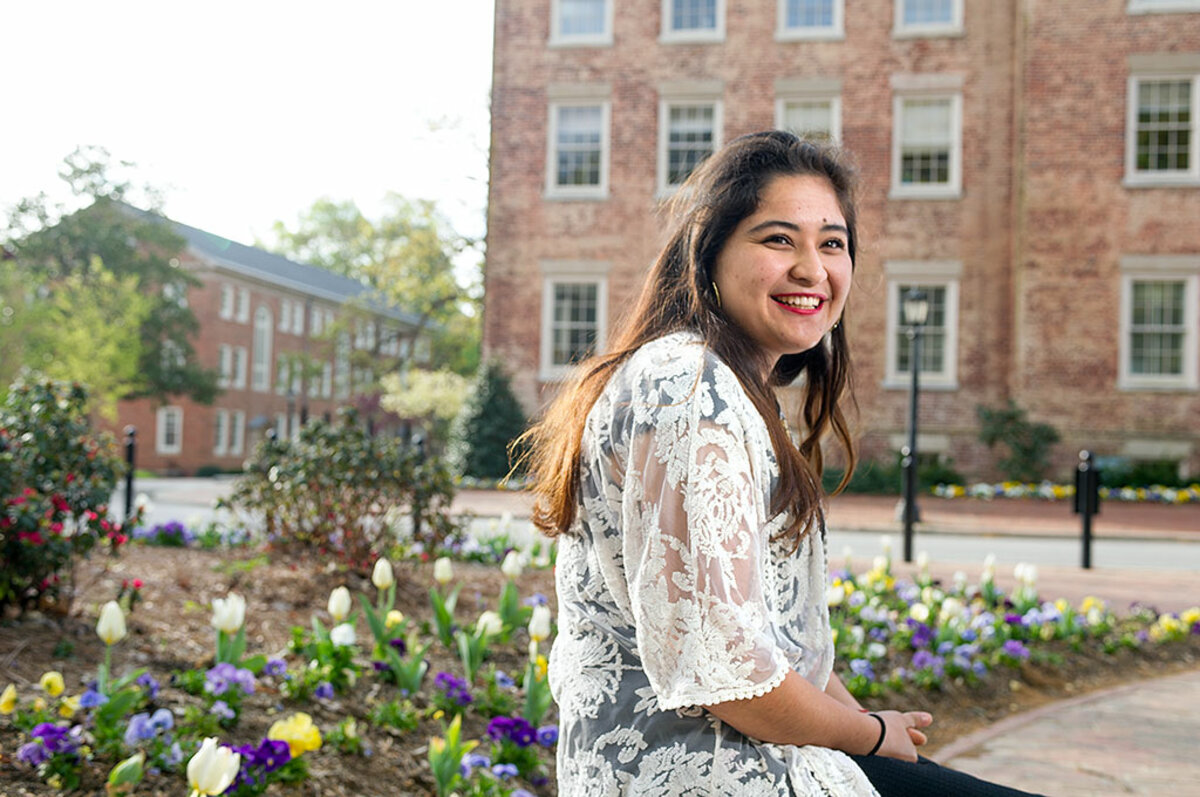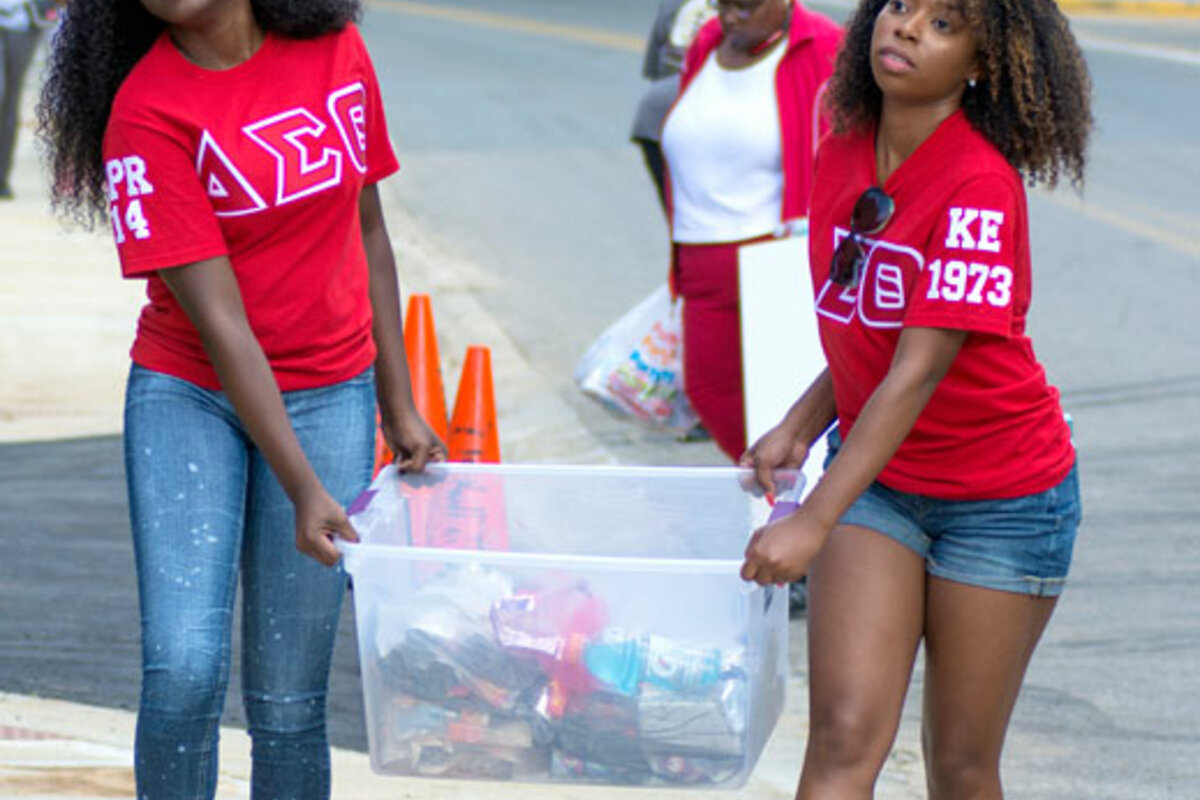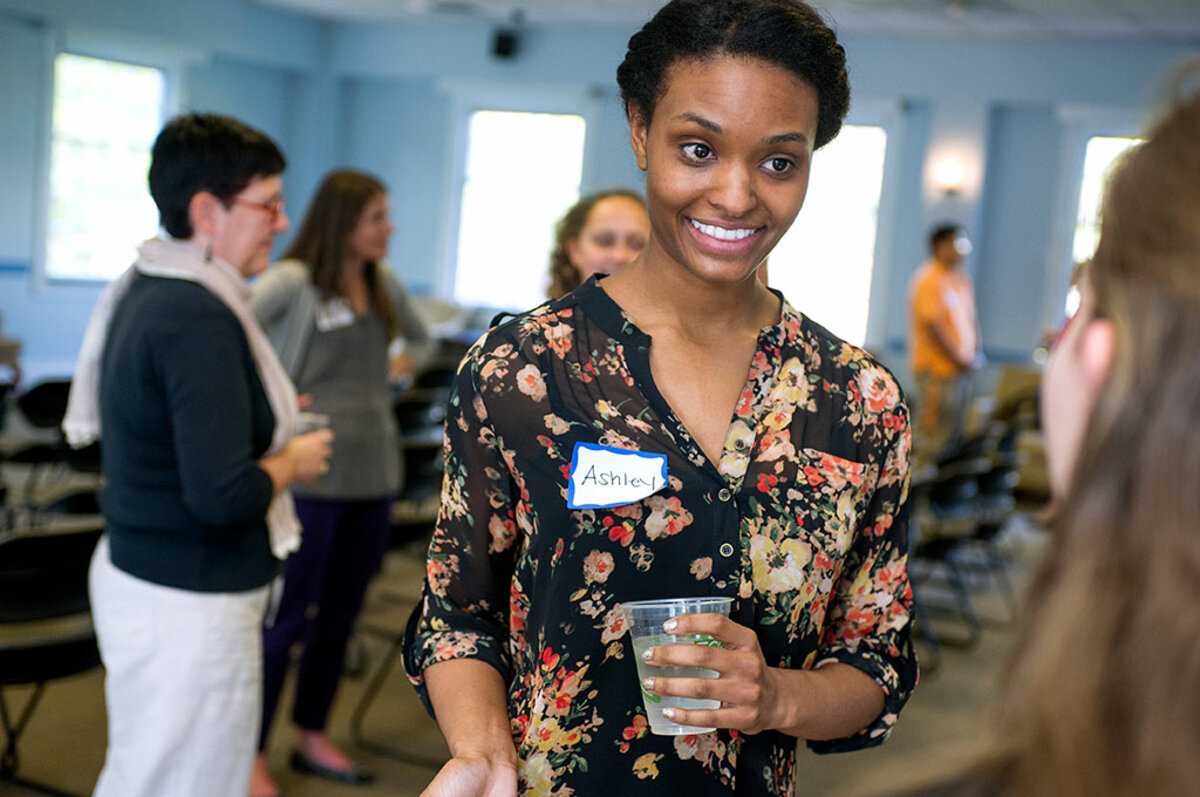Two colleges where diversity works
Loading...
| Chapel Hill, N.C.; and Tallahassee, Fla.
Kelly Hogan was stunned. The biology professor at the University of North Carolina at Chapel Hill (UNC) saw statistics generated by the university that showed something sobering about her Biology 101 class: More than 70 percent of the African-American students and more than 40 percent of Latinos were failing. First-generation students – the first in their families to attend college – were also struggling.
Faced with teaching 400-plus students, Ms. Hogan had resorted to a traditional lecture model. Now, she realized, “nothing I’m doing here is really in line with how learning works.” If she wanted to offer all her students the same chance to learn, she had to change the way she taught.
So she decided to introduce new material through assignments and start classes with a question. She often told students to consult with their neighbors, effectively turning endless tiers of passive teenagers into a buzzing hive. Hogan tried a host of other techniques as well – polling students electronically, for instance, to find out how much they knew about a subject.
Just three semesters later, the results were dramatic. The failure rate among African-Americans fell by half. The percentage who achieved C’s tripled, and more than 10 percent scored A’s and B’s. Latinos and first-generation students improved, too, as did white and Asian students. Today, building on some of the experimentation Hogan began implementing in 2009, UNC is channeling $1.8 million into transforming the way introductory science courses are taught.
This revamping is one small part of UNC’s attempt to improve the racial environment on campus. Across the United States, colleges and universities are launching new initiatives in response to jarring student protests over racism. Students are demanding more than just an increase in the number of minorities in classrooms. They are searching for a sense of belonging that often goes beyond what the civil rights movement fought for a generation ago.
Changing attitudes may well prove to be tougher for universities than boosting minority enrollment. But, as schools search for ways to foster a greater sense of community, experts say that many programs already exist with proven track records that can serve as models.
Just about every institution is doing “something productive around diversity,” says Cassie Barnhardt with the Department of Educational Policy and Leadership Studies at the University of Iowa in Iowa City. “It might not be the whole campus; it might be a program, a class, a teacher, a pipeline initiative.”
Some state schools, even in the face of large student bodies, restrictive budgets, and relatively small endowments, are finding ways to implement successful programs and remain academically competitive. Two often cited for innovative efforts are Florida State University (FSU) in Tallahassee and UNC, both in an area of the country with a history of often troubled race relations.
Neither is without critics. Even though they rank above average nationally in terms of diverse student populations and faculty, neither truly reflects its state’s demographics. Students were quick to point this out during protests at UNC last fall and during FSU’s elections for student government in February.
Their concerns were well founded. Studies show that the most highly diverse campuses have the lowest rates of harassment and discrimination. But they also show that diversity is about more than just having a multiracial student body. This is why UNC and FSU, along with many other schools, have developed programs aimed at fostering inclusiveness from the classroom to the cafeteria.
“Much of what the students that are organizing are really saying is ‘yeah, we’re here, and so now that we’re here, we deserve to have a positive, affirming environment in our classrooms, from our faculty, among the students that we interact with. We shouldn’t have to be having a substandard experience,’ ” says Ms. Barnhardt, whose research focuses on student activism.
• • •
Changing how students feel about the present revolves in part around how they view the past. On a sun-splashed day, Robert Porter leads a group of people on the Black and Blue Tour, a weekly journey through UNC’s African-American history. Even though there are plenty of distractions to occupy them, more than 50 people – most of them students – have shown up to listen to Mr. Porter, a lecturer in the African-
American studies department, as he moves through campus. “If schools had taught us all the real, whole story, our country would be different,” he says.
He begins in the government building before a large mural portraying some 40 African-American educators, activists, writers, and politicians. They are shown at a lunch counter, a tribute to the Greensboro Four who, in 1960, sat at the Woolworth’s “whites only” counter and politely, resolutely refused to move.
For the next hour and a half, Porter points out the “history hiding here in full view” – from slave labor, Civil War, and Reconstruction to Jim Crow laws, civil rights, and black student protests. Pausing at buildings named for white men, he recounts the role the men played in the oppression of fellow humans through slavery and segregation. In front of a dorm, he recalls the difficulties the first African-American female student faced. At the tour’s end, he points out the Sonja Haynes Stone Center for Black Culture and History, which opened in 2004, a full 16 years after the center itself was first established.
Echoing the theme that history is neither an impersonal force nor the handiwork only of those in power, he says, “The building didn’t just appear. It happened because of struggle by students, faculty, and others fighting for it.”
Not coincidentally, when some UNC students at a town hall meeting last November called for a more inclusive campus, they cited the Black and Blue Tour as an inspiration.
Improving the racial climate on campus requires both getting more minorities in classrooms and, just as important, helping them succeed. This was a motivating force behind another novel UNC program – the Carolina Covenant.
Concerned that many low-income kids weren’t even applying to college, Shirley Ort, associate provost and director of scholarships and student aid, came up with a plan in 2003. She calculated that, with an extra $1.4 million a year, she could offer financial-aid packages that would enable students from low-income families not just to attend, but also to graduate debt-free.
The school embraced the concept and, as word spread, donors emerged. To date, the Covenant has raised $8 million of a hoped-for $10 million endowment from individuals and corporations, and it maintains a budget of about $1 million for annual expenses. Elements of the program have been replicated in colleges around the country.
Once students are accepted, Dr. Ort’s office reviews their finances using federal criteria and Profile, a more stringent questionnaire created by the College Board. Students from families at or below 200 percent of the federal poverty level ($48,500 for a four-person household) are automatically invited to become Covenant Scholars.
When the e-mail goes out, it includes a detailed account of what the family is expected to pay, if anything; which federal and state grants, scholarships, and work-study programs the student is eligible for; and how this covers the full UNC experience – from tuition and books to living expenses and study abroad programs. The only condition is that scholars meet federal aid requirements by maintaining a 2.0 GPA. In short, says Ort, “We make it possible for them to graduate debt-free.”
Selina Lopez remembers “crying and almost falling off the chair” when she found out she had been accepted into the program. Her parents, who have a small house-painting business in rural North Carolina, were ready to go into debt to see her attend UNC. Then, two weeks before school started, an e-mail arrived from a group she didn’t even know existed. Selina ran to tell her parents. “My dad teared up,” she says. “It was the first time I saw him get emotional.”
Covenant Scholars now total 2,400, or 13 percent of UNC undergraduates. Their families’ median income is $26,777, and their backgrounds are diverse: 41 percent are underrepresented minorities (all minorities except Asian), 42 percent are white, and 58 percent are first-generation college students.
Once on campus, Covenant staff members act as an information source and fairy godmothers. If grades slip, an academic specialist offers help. If students have a problem, counselors listen and link them to services on campus. Opportunities exist to hang out with fellow Covenant Scholars, connect with peer and faculty mentors, and get free tickets to music and other performances on campus. Students can also sign up for such things as workshops on business networking or an evening with graduate students to learn about applying to graduate schools.
Only about one-third of Covenant Scholars regularly take advantage of such offerings, but Ort is fine with that. “If they come and assimilate just like any other student,” she says, “we think that’s a win.”
Before the program existed, graduation rates for students from low-income families hovered just under 57 percent. Today, almost 81 percent graduate, of which more than half (56 percent) leave debt-free. Those who take out loans most often do so instead of participating in work-study programs, to cover what their parents can’t pay, or to finance summer school. On average, their total college loans run about $10,300.
Don Hornstein, a law professor who chairs the Scholarships, Awards and Student Aid Committee, calculated that without need-based aid, the percentage of highly qualified underrepresented minorities and first-generation students would be halved. “We are all better off when they are here,” he said at a February faculty meeting. “Diversity is a tertiary asset of the university, not just a benefit to those whom financial aid enables to attend.”
An equally successful program at FSU takes a more hands-on approach. Not long after Florida ended segregation and decades before “inclusion” became a buzzword, initiatives geared toward minorities sprang up around campus. In 2000, they merged into CARE, the Center for Academic Retention and Enhancement, which focuses on first-generation, low-income students.
Sheldon Williams, now a senior, entered the program in 2012, joining about 300 other incoming freshmen for what he describes as a seven-week, life-changing Summer Bridge Program. “They give you a stipend,” he says, “free courses, free room and board, free health plan for that summer. They register you for classes, and they give you all these different workshops, show you how to study, show you how to manage your money, how to manage your time, how to talk to different people, how to get connections.”
He stops for an intake of air. “It’s something that actually bridges you throughout your time here at Florida State, like they help you constantly and constantly and constantly.”
As CARE director Tadarryl Starke sees it, “A lot of what we do is letting them know [they] belong here,” and the only way for students to get over “impostor syndrome” is by succeeding academically. So CARE requires a prescribed number of study hours, particularly in the first two years. It tracks academic progress, providing tutoring and coaching as needed.
At the same time, CARE directs students to campus resources and activities so that, as sophomore Maria Montano puts it, “you get out of your comfort zone and meet new people, see new lifestyles.” Maria’s own interests include a couple of volunteer groups, the Delta Sigma Pi professional fraternity, and Global Scholars, with which she will spend 10 weeks teaching in Peru.
CARE quickly showed results. In 2006, 72 percent of the black students at FSU graduated, thanks in great part to the program. Today, the overall graduation rate for CARE students is 81 percent compared with 79 percent for the entire school. CARE students maintain a 3.04 GPA, and 70 of this year’s group of 400 were invited to join freshman honors fraternity Phi Eta Sigma.
“There was a stigma at first,” says Mr. Starke, because students apply directly through CARE, which has more lenient requirements than the university. But CARE also admits high-achieving applicants like Sheldon. “We see and research shows that students usually raise themselves up to the level of the higher achieving student.”
• • •
Diversity programs benefit more than minorities. Take the experience of David Walsh. The FSU sophomore is a self-described white heterosexual male. He has never signed up for anything with diversity, multicultural, or social justice in its title.
“To be completely honest, I’m usually sort of skeptical of leadership, team-building exercises, things like that,” he says. “I just think there can be a lot of fluff sometimes, and I like to see pen-to-paper hard work being done.”
He no longer feels that way. David was actively involved in the student government elections this fall. As he campaigned, he met many students who had participated in diversity training. He was struck by how much more self-aware his peers from less privileged or minority backgrounds were. He says he doesn’t have as good a sense of his own identity and how he can best make a difference. So when an opportunity recently came up to take a six-day group-oriented program called LeaderShape, he applied. He will attend the program this summer.
Research by Nicholas Bowman, director of the University of Iowa’s Center for Research on Undergraduate Education, underscores how substantive such programs can be. Taking just one diversity course, he found, increases students’ interest in ideas and their willingness to engage in what he calls “effortful thinking.” Not just some students. All students.
Besides imparting factual information, these courses require two things: internal work, which, FSU’s vice president of student affairs, Mary Coburn, explains, “is to be aware of what your own identities are and how those shape how you go through life. And then the external work is, ‘now that I know this, what do I do about it? How do I communicate more effectively? How do I become more sensitive to people who are different than I am?”
Typically, the programs take the form of dialogue-based workshops and, except for a diversity class CARE requires, they’re not mandatory. This is key, says Josh Kinchen, who runs workshops about and for the lesbian, gay, bisexual, and transgender community. Participants have to be willing “to engage with the material,” he says.
Rachel Bukanc sees tremendous power in these kinds of intensive programs, too. For her PhD dissertation in education, she spent a year observing and interviewing students at FSU’s Social Justice Living Learning Community. Some 30 first-year students live on a designated dorm floor and, each semester, take a class in which they tackle the thorny issues of privilege, oppression, justice, racism, and various other “isms.” There is nothing formulaic about these discussions, which inevitably spill over into dorm life. Ms. Bukanc says the students learn by “reading and hearing stories,” trying things out, and watching what others do.
By contrast, she says, one-off programs organized in reaction to a campus incident don’t “go deep. The only way you can really see some transformation” is to create an ongoing situation in which students analyze concepts, explore each other’s perspectives, and share personal stories.
One area persistently proved challenging: “They were uncomfortable talking about race,” Bukanc says. She documented an incident in which a white student at her sorority confronted a sister for making a racist remark. She was terrified that the other sisters would hate her for raising it. Instead, says Bukanc, it sparked a dialogue that led to deeper conversations.
Current participants in the program show a similar willingness to wrestle with differences. In the fall, Annemarie Jude discovered that her friend Sabrina Bousbar was as adamantly pro-abortion rights as she herself was antiabortion. As fellow resident Jack Graham describes the scene, “it got heated very quickly. But they were still able to talk about it.” Thinking back on it now, Annemarie says she might handle it a little differently: “I’d do more listening.”
How a school responds to racism can be as telling as trying to prevent it in the first place. In January, a recent FSU graduate reported a racist incident that had happened in 2013. According to news reports, pledges at the fraternity Tau Kappa Epsilon were forced to wear black face makeup and act like slaves in a game called “Old South.” The source waited until everyone involved had graduated before revealing the incident.
The university’s first move was to suspend the fraternity. Then, in February, President John Thrasher and Vice President Coburn invited student leaders in for a meeting. As the president of the Black Student Union, Sheldon was among them. A member of Alpha Phi Alpha, he knows that “being a pledge is already like being the lowest.” So the notion that to belittle them even more by making them appear to be black – “that’s what really resonated with me,” he says.
The student leaders decided to organize an “open dialogue,” and it was clear, Coburn says, that they didn’t want it to be a gathering of only black students. The following Monday, some 600 students assembled in the Student Union, where staff from the Center for Leadership and Social Change facilitated a discussion that began in small groups, then moved to the broader assembly.
The discussions were frank, Sheldon felt, but it bothered him that they had focused on hazing without tackling racism. At the next meeting with Coburn and Mr. Thrasher, he planned to propose a second discussion pegged to race. But then, in conversation with two fraternity brothers, he changed his mind. The three decided to approach the offending fraternity directly. At Tau Kappa Epsilon’s next chapter meeting, he says, “We spoke about how people felt in our community, and we also wanted to hear from them what exactly had happened.”
They learned that, yes, a racially charged incident had occurred, but it was the doing of just a few people who were no longer at FSU and involved only one pledge, not the whole class. Confident that the incident didn’t reflect the views and values of the entire fraternity, he says, they then discussed what each could do to restore trust.
When the student leaders next met with Coburn and Thrasher, they didn’t want to rehash the incident. They wanted to move forward by championing a campus-wide campaign, “Making a Difference Through Our Differences.” As they envision it now, the campaign will act as an umbrella for all groups and host a series of open discussions.
The impact reaches beyond race. Much of what staff and students are doing fits right in with practices that George Kuh, director of the National Institute for Learning Outcomes Assessment, has identified as enhancing students’ learning. “At the end of the day,” Mr. Kuh says, “this is fundamentally about developing trust, which is a precursor for a healthy, safe, educationally powerful community.”








